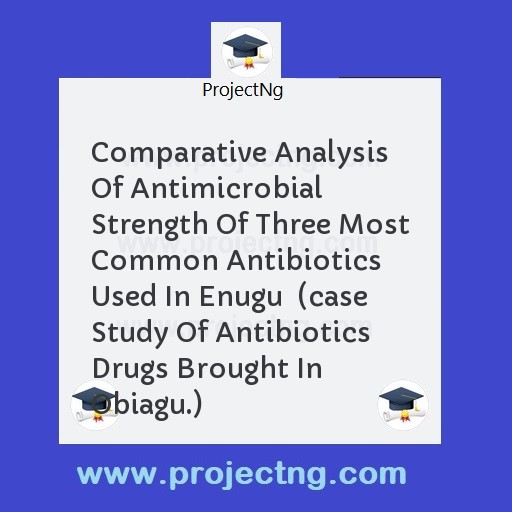Comparative Analysis Of Antimicrobial Strength Of Three Most Common Antibiotics Used In Enugu (case Study Of Antibiotics Drugs Brought In Obiagu.)
Science Lab Technology Project Topics
Get the Complete Project Materials Now! »
COMPARATIVE ANALYSIS OF ANTIMICROBIAL STRENGTH OF THREE MOST COMMON ANTIBIOTICS USED IN ENUGU
(CASE STUDY OF ANTIBIOTICS DRUGS BROUGHT IN OBIAGU.)
ABATRACT
In comparing the antimicrobial strength of three most common antibiotics, which includes: streptomycin chloranphenicol and gentarccin.
Samples of urine and high vaginal swab (H.V.S) were collected from park lane Enugu. The organisms isolated were pure culture of staphylococcus aureus and Escherichia coli
Sensitivity test was carried out with the use of sensitivity disk containing various minimum inhibitory concentration of the different antibiotics.
The result obtained shaved that gentamicn was more effective followed by chloramphenicol while some organisms shaved resistant to streptomycin.
LIST OF TABLE
TABLE 1 NUTRIENT AGAR
TABLE 2 BLOOD AGAR
TABLE 3: ANTIBIOTICS AGAINST SYAPHYLOCOCCUS AUREUS
TABLE 4: ANTIBIOTIC AGAINST ESCHERICHIA COLI
LIST OF FIGURES
FIGURE 1: STREPTOMYCIN
FIGURE 2: CHLORAMPHENICOL
FIGURE3: SENSITIVITY TEST ON STAPHYLOCOCCUS AUREUS
FIGURE 4 SENSITIVITY TEST ON ESCHERICHIA COLI
FIGURE 5: STAPHYLOCOCCUS AUREUS AGAINST ANTIBIOTICS
FIGURE 6: ESCHERICHIA COLI AGAINST ANTIBIOTICS
TABLE OF CONTEANT
Title page
Certification
Dedication
Acknowledgement
Abstract
List of tables
List of figures
Table of contents
CHAPTER ONE
1.0 Introduction
1.1 Historical background
1.2 Aims and objective
1.3 Hypothesis
1.4 Statement of problem
1.5 Scope of study
1.6 Limitation of study
CHAPTER TWO
2.0 Literature review
3.1 Procurement of antibiotics
3.1.1 streptomycin
2.1.2 Chloramphenicol
2.1.3 Gentamicin
2.2 Antimicrobial activity in vitro
2.3 Antimicrobial activity in vivo
2.4 Resistance to antimicrobial drugs
2.5 Factors affecting antimicrobial activity
2.6 Clinical use of antibiotics
2.7 Characteristic of antibiotics
CHAPTER THREE
3.0 Materials and method
3.1 Sample collection
3.1.1 Media composition
3.1.2 Direction for the preparation of nutrient agar
3.1.3 Direction for the preparation of blood agar
3.1.4 Material used for the prewritten of media
CHAPTER FOUR
4.0 Isolation and identification procedures
4.1.1 Isolation and identification of staphylococcus aureus
4.1.2 Isolation and identification of escherichia coli
4.2 Sensitivity test
CHAPTER FIVE
5.0 RECOMMENDATION
5.1 CONCLUSION
REFERENCES
CHAPTER ONE
INTRODUCTION
1.1 HISTORICAL BACK GROUND
Antibiotics are chemicals when the chemical are put into the body, they stop the growth of kinds of germs. They help the body to fight diseases. More than 3,000 years ago ancient people stumbled over the discovery that some moulds could be used as a cure. The egyptians, the chinese, and indians of central American would use mold to treat rashes and infected would. At that time they didn’t understand either diseases or treatment. As time went on, people began to gain some insight of disease. In the 1860 Louis Pasteur Shaw that many disease were caused it bacteria. Later he discovered that we may be able to fight germ and other microbes. It was two German doctors, who were first to make an effective medication form microbes. Kudo if and Emmerich and Oscar has conducted their experiment in the 1890. They proved that germ that would for another. All the men did was to take the germ from infected bandages and grow then in a test tube. They would then isolate a particular germ that caused green in factions in open would. This germs was bacteria called Bacillus pyoicyaneus. They put then into another test tube containing other type of bacteria, it was then it happened that the bacillus pyocyaneus wiped out the other disease germ. The germs that was killed were those that
Be the First to Share On Social

Enjoying our content?
Don't miss out on new videos! Subscribe to our YouTube channel for more awesome content.
Subscribe Now!













